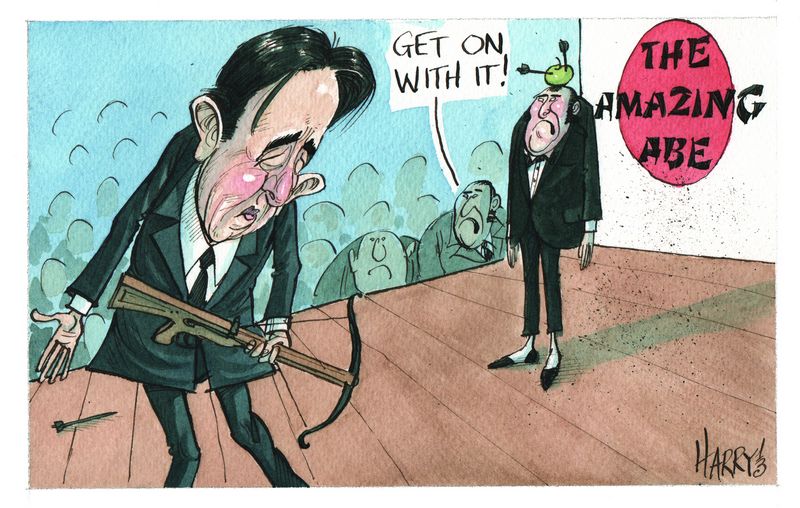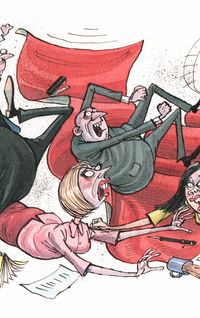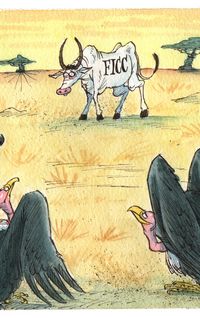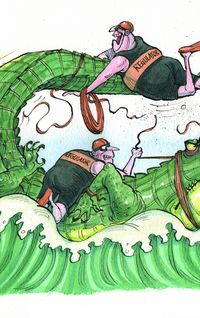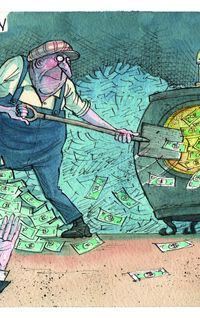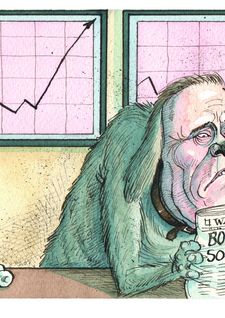Japan’s unprecedented monetary experiment has won it cautious approval from the rest of Asia, but will the so-called third arrow of greater structural reform actually arrive? Much is riding on the country’s ability to deliver on its promises.
Abenomics looks to be pulling Japan out of its decades-long torpor, but its near-term impact across Asia remains decidedly mixed. While the surge in the Nikkei Index and the stream of Japanese acquisitions in South-East Asia will continue, China and South Korea could unleash their own measures to protect against a devalued yen.
The long-term effects of Abenomics on both Japan and the wider Asian region will depend on Prime Minister Shinzo Abe’s ability to deliver on badly needed structural reforms. However, the year-old stimulus programme – a bold attempt to eradicate deflation via currency devaluation, labour policy reform, and spending on infrastructure – is already scoring points for its positive impact on inbound and outbound investments across the region.
“Japan was considered a sleepy market until Abe’s arrival,” said Izumi Devalier, a Hong Kong-based economist with HSBC. “That has changed in the past year. Turnover of Japanese equities by foreigners reached a record ¥108trn [US$1.08trn] from April to June 2013.”
“Investors have revised their Japan underweight positions. The excitement died down somewhat in Q3 2013, but the investing community is looking closely at Japan again,” Devalier said.
The Nikkei had surged more than 40% by the middle of November, although the rally has often given way to doubts that Japan will truly be able to break through decades of stagnation and deliver on the entire suite of structural reforms.
The reforms are also prompting Japanese investors to move more capital beyond their borders. Japanese investors’ net outward portfolio investments into Asian equities in the first half of 2013, for example, amounted to ¥305.6bn, up from ¥232.3bn in the preceding six months, according to HSBC’s Devalier.
South-East Asia is a particularly popular destination for Japanese funds as investors seek returns abroad.
“Trading amounts in both inward and outward [flows] increased, compared with January–September 2012,” said Harumi Taguchi, principal economist at research firm IHS. “By country, Japanese investors are net buyers in the Philippines, Malaysia, Vietnam and Singapore.”
Thailand’s equity market also stands to gain from a sustained economic resurrection in Japan.
“In Asia, Thailand has the closest trade ties with Japan and I would expect the SET [Stock Exchange of Thailand] would experience the greatest repricing for improved economic prospects in Japan,” said Tim Condon, chief economist, Asia, ING Bank.
The outward investment goes far beyond short-term equity portfolios. Newly confident Japanese companies have gone on buying sprees in Asia this year as they pivot away from China, although acquisitions will become increasingly expensive for Japanese buyers if the yen depreciates too much.
Two such examples are Sumitomo Mitsui Banking Corp’s agreement to acquire a 40% stake in Indonesia’s Bank Tabungan Pensiunan Nasional for roughly US$1.5bn and Mitsubishi UFJ’s US$5.6bn bid in July for a majority interest in Thailand’s Bank of Ayudhya.
QE conundrum
The so-called “three arrows” of Abenomics, namely monetary stimulus, fiscal stimulus of ¥10.3trn and growth-enhancing structural reforms, are fairly conventional, yet nonetheless bold initiatives for a country that has slumped under 15 years of deflation and become a “zombie” economy.
The first arrow, a vigorous programme of quantitative and qualitative easing, has arrested deflation, but concerns remain that the 1.9% inflation figure projected for 2015 may remain out of reach.
Moreover, Japan’s ambitions are not immune to the influence of neighbours, such as South Korea and China, who could blunt the impact of such strident QE if they choose to follow a similar agenda.
“Should other central banks now choose to relaunch their own QE programmes, this could overshadow the BOJ [Bank of Japan] and dilute the market impact of their efforts,” said Stefan Hofer, emerging market economist at Julius Baer. “However, this seems very unlikely under current circumstances.”
Hofer said a surging Nikkei and increased inbound and outbound investment flows were beneficial to Asian countries, suggesting policymakers were supporting Japan’s experiment – at least for now.
“As of yet, most countries in Asia would recognise that a Japanese economy with a higher growth path is, on balance, good for the region in that Japanese demand for imports from the region should eventually rise,” Hofer said.
Unappreciated depreciation?
Regional powerhouses like South Korea and China may also worry that the boost a cheaper yen has to Japanese exports will damage their own competitive advantages, particularly on exports.
The yen has depreciated more than 20% year to date, causing Japanese equities to climb and leading to an improvement in consumer and business confidence, according to HSBC’s Devalier.
“Korea and China may not be supportive because the yen devaluation lowers their competitiveness,” said Harumi Taguchi of IHS. “The BOJ’s monetary easing seems to be accepted so far, thanks to Governor Haruhiko Kuroda’s links with the Asian central banks from his previous career as the [Asia Development Bank’s] governor.”
Despite the potential for retaliation from regional neighbours, a cheaper yen is essential to keep Japan’s markets, and burgeoning investor interest, on the upswing. Consensus has the yen at 105 to the US dollar come the end of the first quarter of next year from about 100 now, according to ING’s Condon.
“Yen depreciation and stock market appreciation represent market repricings for increased monetary accommodation,” said Condon.
“If there is no third arrow of Abenomics to boost growth, the repricing for increased BOJ accommodation will run its course and the yen depreciation and stock market rally would halt. Confidence-sensitive capital outflows from the stock market could appreciate the yen in that case.”
Threat of FDI trickle
Beyond QE and fiscal stimulus, the first two arrows, comes the much-touted third arrow of Abenomics – structural reform. Without it, Japan’s resurgence will grind to a halt as Asian investors lose confidence that the world’s second-largest developed economy can fix dysfunctional polices in the areas of immigration, labour, and the pension system.
In October, the Diet authorised a bill to strengthen Japan’s industrial competitiveness. The legislation, which calls for greater support for SMEs, the establishment of a special scheme for corporate validation, the introduction of incentive-based tax schemes for venture companies and business reorganisation, is expected to be the flagship for economic reform over the next few years.
“Progress has come in fits and starts, but there’s been little progress on what we believe is the most important plank of these reforms – labour market deregulation,” said HSBC’s Devalier.
The measures are aimed primarily at deregulating and freeing up the Japanese corporate sector, as well as encouraging innovation and entrepreneurship, including the introduction of zones for deregulation in fields as diverse as medical treatment to urban development – in part to attract more foreign investments.
Not enough was being done to encourage overseas investors to ramp up foreign direct investment into Japan, Devalier said, adding that, without significant reform to the country’s “stifling” regulation and infamous bureaucracy, inward FDI would remain at a trickle.
China factor
While Abe has his work cut out for him at home, the deciding factor for the success or failure of Abenomics and its effects on Asia could come from an event beyond Japan’s borders.
“A hard landing in China, Japan’s largest [outward] trading partner, would be a large, adverse shock to Japan’s economy,” said ING’s Condon.
However, a minor slowdown in China, rather than a crash that would crush trade, may benefit Japanese companies as they regain their footing, thanks to a cheaper yen, and as they gain a revitalised sense of efficiency and competiveness after the delivery of structural reforms.
“Slower growth in China, without a hard landing, could give Japanese producers some respite from [competitive pressure] from neighbouring country producers,” Condon said.
In addition to a hard landing for the world’s second-largest economy, any number of “black swan” events may also lurk on the murky horizon – events that could potentially derail Abenomics and its progress.
“Any global risk-off event that causes the yen to appreciate also threatens Abe’s project since so much of the stock market rally of the past year has been built on a weaker currency,” said HSBC’s Devalier.
Still, despite the challenges of keeping the yen cheap, executing on promises of painful structural reforms, and navigating the turbulent geopolitical waters, Japan is officially “back on the map” for investors and policymakers across the region, according to Julius Baer’s Hofer.
“The advent of Abenomics appears to be accelerating a further internationalisation of Japan’s economy,” said Hofer. “In this regard, Japan is [again] a topic of discussion in the region and beyond.”
To see the full digital edition of the IFR Review of the Year, please click here.
To purchase printed copies or a PDF of this report, please email gloria.balbastro@thomsonreuters.com
